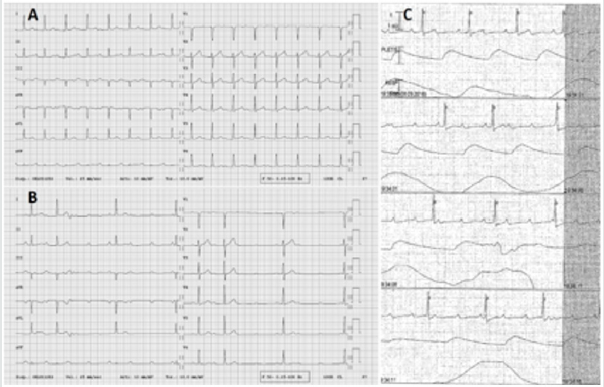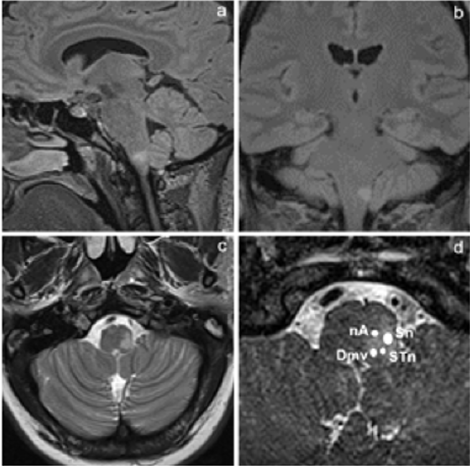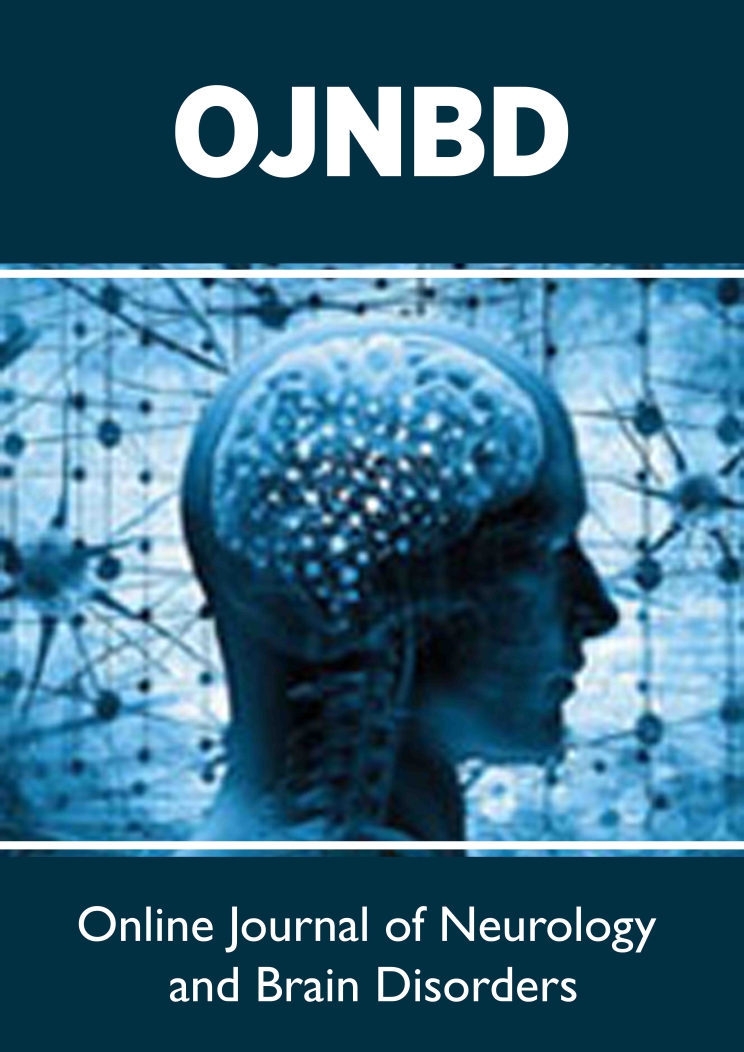
Lupine Publishers Group
Lupine Publishers
Menu
ISSN: 2637-6628
Case Report(ISSN: 2637-6628) 
Co-Occurrence of High Degree Atrioventricular Block and Facial Pain in Lateral Medullary Stroke Volume 4 - Issue 4
Shairin Sihabdeen1, Elisa Ventura2, Carlo W Cereda1, Claudio Staedler1, Giacomo Chiaro1,3 and Mauro Manconi3,4,5*
- 1Department of Neurology and Stroke Center, Neurocenter of Southern Switzerland, Lugano, Switzerland
- 2Department of Neuroradiology, Neurocenter of Southern Switzerland, Lugano, Switzerland
- 3Sleep Center, Neurocenter of Southern Switzerland, Lugano, Switzerland
- 4Faculty of Biomedical Sciences, Università della Svizzera Italiana, Lugano, Switzerland
- 6Department of Neurology, University Hospital Inselspital, Bern, Switzerland
Received: October 05, 2020; Published: October 14, 2020
Corresponding author: Mauro Manconi, Sleep Medicine, Neuro-center of Southern Switzerland, Regional Hospital of Lugano, Via Tesserete 46, 6903 Lugano, Switzerland
DOI: 10.32474/OJNBD.2020.04.000195
Abstract
Background: Besides the typical alternate clinical picture, Wallenberg syndrome may be rarely associated with facial pain due to the involvement of the trigeminal nucleus, and sudden death.
Case: We report a case of lateral medullary infarction associated with potentially life threatening intermittent high degree atrioventricular block which occurred in close temporally association with severe facial pain exacerbations. The case required an urgent implantation of cardiac pacing. We hypothesized that the AV-block was triggered by vasovagal response to centrally-mediated pain. However, a direct involvement of the autonomic brainstem network (solitary tract nucleus and dorsal motor nucleus) could not be excluded.
Conclusion: A similar sequence of events might explain at least part of the unexplained sudden deaths that seldom accompany Wallenberg syndrome. This report highlights the importance of continuous cardiac monitoring, in the acute phase of lateral bulbar ischemia, in order to prevent unfavorable outcome.
Keywords: Wallenberg Syndrome; Facial Pain; Trigeminal Nucleus; Atrio-Ventricular Block; Cardiac Arrythmia; Vaso-Vagal Response
Introduction
Wallenberg syndrome is the most frequent clinical
manifestation of brainstem ischemia, and it is due to lateral
medullary infarction consequential to the occlusion of the posterior
inferior cerebellar artery or vertebral artery. The typical alternate
clinical picture includes: vertigo with nystagmus and nausea
(inferior vestibular nucleus); dysphonia, dysarthria, and dysphagia
(nucleus ambiguous, NA); Horner syndrome (sympathetic fibers);
ipsilateral limbs ataxia (restiform body, spinocerebellar fibers,
inferior cerebellar peduncle); impaired ipsilateral facial sensory
perception (trigeminal nucleus); pain and temperature perception
impairment in the contralateral limbs (spinothalamic tract) and,
when there is damage of the ventral medulla, minimal weakness of
the contralateral limbs (cortico-spinal tract) [1].
However, depending on the topography of the lesion, other
peculiar symptoms might be associated with lateral bulbar
infarction. Among these, ipsilateral facial pain, which often recalls trigeminal neuralgia, is well described in the literature [2-5].
Although infrequent, sudden death might occur in Wallenberg
syndrome, representing the most serious accompanying event
[6,7].
Herein, we describe and speculate on the pathogenesis of a peculiar case of Wallenberg syndrome, in which fluctuating severe facial pain and high degree atrioventricular block co-occur with a close temporal relationship.
Case Report
Figure 1: EKG pattern recorded during the acute phase of bulbar stroke in three different conditions. (A) First- degree atrioventricular conduction block during asymptomatic (inter-critical) basal recording; (B) third-degree atrioventricular conduction block during one episode of facial pain (critical); (C) transition from a first-degree atrioventricular conduction block to a third-degree atrioventricular conduction block in coincidence with a sudden severe facial pain exacerbation.

A 42-years-old overweight and smoking woman, with untreated
hypertension, referred to the emergency room for acute and severe
pain in her left ear, which rapidly extended to the left side of face.
Symptoms were accompanied by dizziness and mild hypoesthesia
of the left arm. Facial pain fluctuated in its severity, with the highest
peaks accompanied by bradycardia of up to 33 bpm and presyncopal
symptoms. Simultaneous ECG monitoring showed a new seconddegree
atrioventricular (AV) block, which, in coincidence with pain
exacerbations, alternated with a transient third-degree AV block
(Figure 1). These arrhythmias required the urgent positioning of a
temporary external pacemaker.
Cardiac ultrasound, coronary angiography, hematological tests
and brain angio-CT were normal. One day later, a brain diffusion
magnetic resonance imaging (MRI) disclosed an acute ischemic
lesion in the left medulla. The neurological examination showed
an alternated lateral medullary syndrome with ipsilateral (left
side) facial pain and impairment of temperature sensitivity, upper
limb hypoesthesia with mild strength deficit, upper and lower
limbs ataxia; and contralateral (right side) impairment of pain and
temperature sensitivity of the trunk and limbs.
The transient stabbing facial pain exacerbations, as well as
the accompanying high degree AV blocks, disappeared within 24
hours, and the pacemaker was removed after 48 hours from its
implantation. Four days after symptoms’ onset, a second brain MRI
scan confirmed a demarcated latero-posterior bulbar subacute
ischemic lesion (Figure 2). Pregabalin was titrated up to 150 mg/
day with benefit on pain and sensory symptoms.
Figure 2: Sagittal and coronal T2-FLAIR (a, b) and axial T2 TSE (c) images demonstrate a focal hyperintense ischemic lesion in the left dorso-lateral aspect of medulla (vascular territory of the postero-inferior cerebellar artery). A 3D high-resolution T2- SPACE axial image (d) shows the anatomical location of the left X cranial nerve nuclei (Dmv: dorsal motor nucleus of vagus nerve, STn: solitary tract nucleus, nA: nucleus ambiguus) and the V cranial nerve spinal nucleus (Sn) within the medulla.

Discussion
To the best of our knowledge, this is the first observation of
Wallenberg syndrome associated with acute fluctuating highdegree
AV block occurring in coincidence with severe stabbing
facial pain. The clinical picture and the MRI, recapitulate the lateral
bulbar syndrome, with involvement of: lower parts (pars caudalis
and interpolaris) of the trigeminal nucleus (ipsilateral lower face
pain); restiform nucleus (ipsilateral ataxia); medial lemniscus tract
(ipsilateral upper limb mild hypoesthesia); vestibular nucleus
(dizziness); cortico-spinal tract (ipsilateral mild upper limb palsy);
and spinothalamic tract (contralateral limbs and body pain and
impairment of temperature sensitivity) [8].
The acute pain, initially reported by the patient in her ear, is in
line with spinal trigeminal nucleus receiving pain input from the
ear pinna. The basis of the fluctuating AV block is more uncertain,
with two possible mechanisms explaining its origin. Firstly, the
stroke involved the lower trigeminal spinal nucleus, causing intense
ipsilateral facial pain, which in turn favored the AV block by means
of a vasovagal response. Secondly, the ischemic lesion involved
autonomic brainstem networks (IX and X cranial nerves), such as
the solitary tract nucleus (STN) and/or the dorsal motor nucleus
of the vagus nerve (DMV), with the first collecting autonomic
visceral afferent from the carotid body, carotid sinus, aortic
bodies and sinoatrial node, and the second one projecting efferent
to the heart. A further, albeit less probable mechanism, might
involve the trigemino-cardiac reflex, which consists in a reflexive
response to mechanical, electrical or chemical stimulation of the
trigeminal nerve and/or ganglion or brainstem centers during
surgery/angiography, leading to severe dysrhythmias and arterial
hypotension [9,10]. Such reflex, however, is usually mediated by an
external stimulus, which is missing in the present case.
Our first hypothesis (vasovagal response to pain) is supported
by the tight temporal co-occurrence between stabbing pain
exacerbations and AV blocks (Figure 1). Fibers from the trigeminal
nerve have been shown to project to the STN and some authors
described a connection between the trigeminal ganglion and the
vagus nerve [9,11,12]. Moreover, against the second hypothesis
(direct involvement of STN) stands the absence of gustatory deficits,
which indicates a possible sparing of the STN.
On the other hand, based on MRI scan, the lesion seemed to
involve both medial and lateral medulla areas in its posterior part,
while only touching the lateral area in its frontal part. These findings
support our second hypothesis (direct autonomic impairment) of a
direct involvement of both STN and DVM. The nucleus ambiguous (antero-medial medulla area) was spared, and this could explain
the absence of bulbar motor symptoms (dysarthria, dysphagia and
dysphonia) (Figure 2 c, d).
Trigeminal neuralgia secondary to lateral medullary infarction
is a well-described rarity [2-5]. Vagal-mediated first- and seconddegree
AV blocks have been observed [13], while a third-degree AV
block secondary to a pain-related vagal activation has never been
described. Koay et al. documented a case with several asymptomatic
sinus arrests in a patient with left lateral medulla infarction. As well
as in our case, the authors did not find any clear cardiac disease,
and treated the patient with a permanent PM [6].
The present observations yield three interesting speculations:
1) At least part of the sudden deaths described in Wallenberg
syndrome might indeed be due to a non–documented high-degree
AV block. Even in our case, a delay of pacing intervention could have
had lethal consequence;
2) Occurrence of intense facial pain possibly favors vasovagal
responses with variable impairment of AV conduction;
3) Previous cases of sudden deaths in Wallenberg syndrome
should be revisited in order to check for co-occurrence of severe
facial pain. Based on these speculations, we recommend to monitor
ECG already in ER in all cases of lateral medulla syndrome, being
prepared for possible heart pacing, especially in cases accompanied
by facial pain.
Conflicts of Interests
The authors certify that they have no affiliations with or involvement in any organization or entity with any financial interest (such as honoraria; educational grants; participation in speakers’ bureaus; membership, employment, consultancies, stock ownership, or other equity interest; and expert testimony or patentlicensing arrangements), or non-financial interest (such as personal or professional relationships, affiliations, knowledge or beliefs) in the subject matter or materials discussed in this manuscript.
References
- Albert F Peterman, Robert G Siekert (1960) The Lateral Medullary (Wallenberg) Syndrome: Clinical Features and Prognosis. Medical Clinics of North America 44(4): 887-896.
- Carlos M Ordás, María L Cuadrado, Patricia Simal, Raúl Barahona, Javier Casas, et al. (2011) Wallenberg’s syndrome and symptomatic trigeminal neuralgia. J Headache Pain 12(3): 377-380.
- Abinayaa Ravichandran, Kareem S Elsayed, Hussam A Yacoub (2019) Central Pain Mimicking Trigeminal Neuralgia as a Result of Lateral Medullary Ischemic Stroke. Case Reports in Neurological Medicine Pp: 1-3.
- Jong Sung Kim (1993) Trigeminal Sensory Symptoms due to midbrain lesion. Eur Neurol 33(3): 218-220.
- D Canovas, J Vinas, A Rovira (2004) Lateral bulbar infarction with involvement of the trigeminal spinal nucleus. Neurologia 19(1): 23.
- Shiwen Koay, Bikash Dewan (2013) An unexpected Holter monitor result: multiple sinus arrests in a patient with lateral medullary syndrome. BMJ Case rep 2013:bcr2012007783.
- Jaster JH, Porterfield LM, Bertorini TE, Dohan FC Jr, Becske T (1995) Cardiac arrest following vertebrobasilar stroke. J Tenn Med Assoc 88(8): 309.
- Jong S Kim (2003) Pure lateral medullary infarction: clinical-radiological correlation of 130 acute, consecutive patients. Brain 126(Pt 8): 1864-1872.
- David F Bauer, Andrew Youkilis, Christine Schenck, Christopher R Turner, B Gregory Thompson (2005) The falcine trigeminocardiac reflex: case report and review of literature. Surgical Neurology 63(2): 143-148.
- Takamitsu Tamura, David E Rex, Miklos G Marosfoi, Ajit S Puri, Matthew J Gounis, et al. (2016) Trigeminocardiac reflex caused by selective angiography of the middle meningeal artery. J Neurointerv Surg 9(3): e10.
- Kumada M, Dampney RA, Reis DJ (1977) The trigeminal depressor response: a novel vasodepressor response originating from the trigeminal system. Brain research 119(2): 305-326.
- Reiji Kishida, Tjard de Cock Buning, Jacob L Dubbeldam (1983) Primary vagal nerve projections to the lateral descending trigeminal nucleus in boidae (Python molurus and Boa constrictor). Brain Res 263: 132-136.
- Paolo Alboni, Anna Holz, Michele Brignole (2013) Vagally mediated atrioventricular block: pathophysiology and diagnosis. Heart 99(13): 904-908.

Top Editors
-

Mark E Smith
Bio chemistry
University of Texas Medical Branch, USA -

Lawrence A Presley
Department of Criminal Justice
Liberty University, USA -

Thomas W Miller
Department of Psychiatry
University of Kentucky, USA -

Gjumrakch Aliev
Department of Medicine
Gally International Biomedical Research & Consulting LLC, USA -

Christopher Bryant
Department of Urbanisation and Agricultural
Montreal university, USA -

Robert William Frare
Oral & Maxillofacial Pathology
New York University, USA -

Rudolph Modesto Navari
Gastroenterology and Hepatology
University of Alabama, UK -

Andrew Hague
Department of Medicine
Universities of Bradford, UK -

George Gregory Buttigieg
Maltese College of Obstetrics and Gynaecology, Europe -

Chen-Hsiung Yeh
Oncology
Circulogene Theranostics, England -
.png)
Emilio Bucio-Carrillo
Radiation Chemistry
National University of Mexico, USA -
.jpg)
Casey J Grenier
Analytical Chemistry
Wentworth Institute of Technology, USA -
Hany Atalah
Minimally Invasive Surgery
Mercer University school of Medicine, USA -

Abu-Hussein Muhamad
Pediatric Dentistry
University of Athens , Greece

The annual scholar awards from Lupine Publishers honor a selected number Read More...




